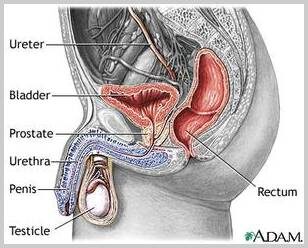
Enlarged Prostate
The prostate is a walnut sized gland located beneath the bladder and in front of the rectum in men. While all of its functions are not completely known, the prostate adds fluid and nutrients to sperm to produce semen and allow the sperm to move more effectively. An enlarged prostate, also known as benign prostatic hyperplasia (BPH), is a common condition that occurs in aging. BPH causes the prostate to press against the urethra which results in urinary problems. It is believed that an enlarged prostate may be due to an excess of certain hormones in the body. There is also believed to be a genetic component.
Symptoms of an Enlarged Prostate
As men mature, the prostate goes through two main phases of growth, first during puberty and again around the age of 25. This second growth phase may continue for many years, and can eventually lead to prostatic enlargement. This can start to affect urination. Symptoms can range from very minimal to very severe. It is very common, in fact, more than 50 percent of men aged 50 and older are affected by this condition in some capacity. As the prostate expands, more and more urinary problems develop. Men with an enlarged prostate may experience some or all of the following:
● Difficulty initiating urine stream
● Inability to completely empty the bladder or sensation that unable to empty completely
● Slower urinary stream
● Frequent urination
● Sudden urge to urinate
● Inability to hold urine (incontinence or urinary dribbling)
● As symptoms progress, patients may also develop bladder stones, blood in the urine or a bladder infection. This condition will continue to worsen if left untreated and prostate continues to enlarge.
Diagnosis of an Enlarged Prostate
An enlarged prostate is diagnosed after a thorough physical examination by you provider, which may also include the following additional tests:
● Digital rectal exam to evaluate prostate sizing
● Urinalysis to look for infection
● Prostate specific antigen test or PSA to screen for prostate cancer
● Cystoscopy
● Post void bladder can to evaluate for retained urine
● A series of urodynamic tests may also be performed to evaluate the function of the bladder and the urinary tract.
Non-Surgical Treatment of an Enlarged Prostate
Treatment for an enlarged prostate will vary depending on the severity of the condition and patient preference. Patients with mild symptoms may only need to monitor their condition for signs that it is worsening, while worse cases may require medication to inhibit hormone production or relax the muscle in the prostate. Two common types of medication for an enlarged prostate include:
Alpha Blockers
Alpha blockers relax the muscles in the bladder and prostate. They can help improve urine flow and reduce risk of bladder obstruction. They are often prescribed to men with smaller prostates. There are many cost effective medications in this class
5-Alpha Reductase Inhibitors
5-alpha reductase inhibitors block the male hormone that stimulates the prostate which cause it to grow. These drugs are generally prescribed to men with significantly enlarged prostates. In addition to relieving symptoms, 5-alpha reductase inhibitors increase urinary flow and may even help shrink the prostate. This class of medications may take 3-6 months to start working.
In some cases, a combination of both medications has proven to be effective in slowing the progression of the disease and alleviating symptoms.
Surgical Treatment of an Enlarged Prostate
In some cases, surgery may be recommended to remove the prostate tissue that is blocking the flow of urine. There are several different surgical procedures available for treating an enlarged prostate, including:
Transurethral Surgery
Transurethral resection of the prostate, otherwise known as TURP, is a surgical procedure used to treat an enlarged prostate with no external incisions. A resectoscope is inserted through the urethra, and tissue is removed from the center of the enlarged prostate. This will hope make urethra more open and more easily able to urinate
Urolift
Urolift is a surgical procedure where small implants are placed through the urethra to open up the obstruction of the urethra from an enlarged prostate. Not all prostates are a candidate for the procedure. It is most effective in men with mild to moderately enlarged prostate. There are minimal side effects from this procedure.
Vapor therapy of the prostate
Vapor therapy of the prostate is a surgical procedure for the treatment of enlarged prostate. It uses steam injected through the urethra to shrink the prostate. This procedure has a slower recovery as the prostate tissue is treated with steam and then the tissue is reabsorbed by the body. There are no cuts or incisions made.
